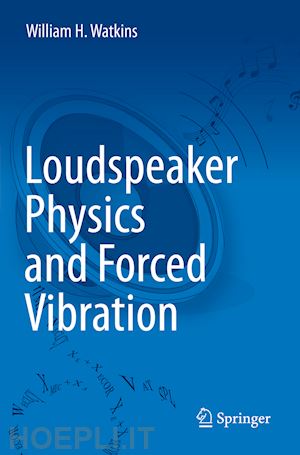
Questo prodotto usufruisce delle SPEDIZIONI GRATIS
selezionando l'opzione Corriere Veloce in fase di ordine.
Pagabile anche con Carta della cultura giovani e del merito, 18App Bonus Cultura e Carta del Docente
This book is a study of the workings of dynamic loudspeakers and dynamically forced vibration. With its wealth of practical observations and real-life examples, this work will prove invaluable to the practicing motor design or loudspeaker design engineer, as well as researchers and students in electroacoustics.
The book is based on a lifetime’s accumulated knowledge by acclaimed speaker designer William H. (Bill) Watkins. It differs from the usual tone of most technical books on this subject by initially presenting, and analyzing in full, the function of each key parameter of a reference dynamic loudspeaker. Each parameter’s value is then calculated and also confirmed via lab measurements to vividly illustrate all energy-transduction facets of loudspeaker operation and the forced vibration. This presentation style makes the analysis both more engaging, intuitive, and easier to comprehend compared to most previous works in the field. The principles of this book apply toall direct reciprocating motors, not just those in a dynamic loudspeaker. Unique to the book is an entire chapter dedicated to the discussion of back-EMF voltage, discussed from several technical points of view and analyzed in depth as related to the dynamic transfer of energy between the mechanical and electrical domains. Another unique feature is a detailed discussion of Watkins’ patented dual-motor concept to achieve high dynamic speaker performance in the region of its low-frequency resonance.William H. (Bill) Watkins was a true American audio innovator. Developer of the famous Watkins “Dual-Drive Woofer”, the renowned WE-1 large floor-standing speaker system, the recently introduced compact Generation 4 unit, and numerous other high-performance speakers, he passed away at his home February 1, 2018 in Kingsport, TN.
He was a veteran of the U.S. Army in the Korean War era and served in active duty overseas. In his youth he became an accomplished musician, especially on the mandolin, guitar, and violin.
He was also a long-time member of the Audio Engineering Society, which he originally joined in 1974. He maintained an extensive library of AES publications over a span of several decades, which he heavily utilized in his ongoing audio and electroacoustics research and development activities.
He had been involved in the high-fidelity audio business in Kingsport since the late 1950s, having owned and operated Watkins Stereo, a retail and custom audio firm, andWatkins Engineering, which manufactured several of his later advanced loudspeaker systems, including the highly regarded WE-1 and Generation 4 models. He was granted three U.S. patents in the area of acoustics, including U.S. #3,838,216 in 1974 for the Dual-Drive Woofer concept, which significantly improved low-end performance of an acoustic-suspension system by effectively cancelling the low-frequency resonance impedance peak, thus extending the bass frequency response by close to an octave.He also authored a landmark article on the technology, "New Loudspeaker with Extended Bass," in the December 1974 edition of Audio magazine. The patented concept was subsequently licensed to Infinity Systems in California for use in many of their high-end speaker systems and soon became widely known as the "Infinity/Watkins" Woofer. In 1982 Watkins collaborated with his son Bill Jr. on a second patent, U.S. #4,443,744, on reviewer-acclaimed sound-damping panels for home listening use, later marketed as the Watkins Echo Muffs. A third patent, on resistively damped crossover networks to optimize speaker transient response, U.S. #4,475,233, was issued to Watkins in 1984.
His prolific speaker design career continued into the 21st century, culminating in the current highly reviewed compact Generation 4, a two-way system incorporating multiple patent-pending features to assure unusually wide, smooth frequency response, along with precise damping and stereo imaging from a small (½ ft3) enclosure.











Il sito utilizza cookie ed altri strumenti di tracciamento che raccolgono informazioni dal dispositivo dell’utente. Oltre ai cookie tecnici ed analitici aggregati, strettamente necessari per il funzionamento di questo sito web, previo consenso dell’utente possono essere installati cookie di profilazione e marketing e cookie dei social media. Cliccando su “Accetto tutti i cookie” saranno attivate tutte le categorie di cookie. Per accettare solo deterninate categorie di cookie, cliccare invece su “Impostazioni cookie”. Chiudendo il banner o continuando a navigare saranno installati solo cookie tecnici. Per maggiori dettagli, consultare la Cookie Policy.